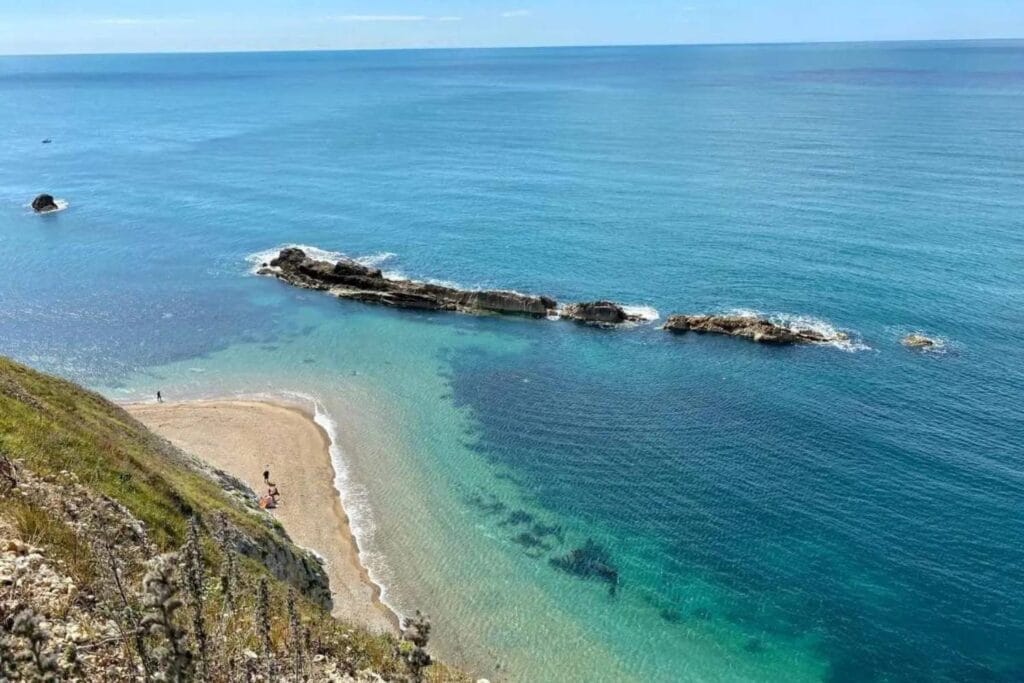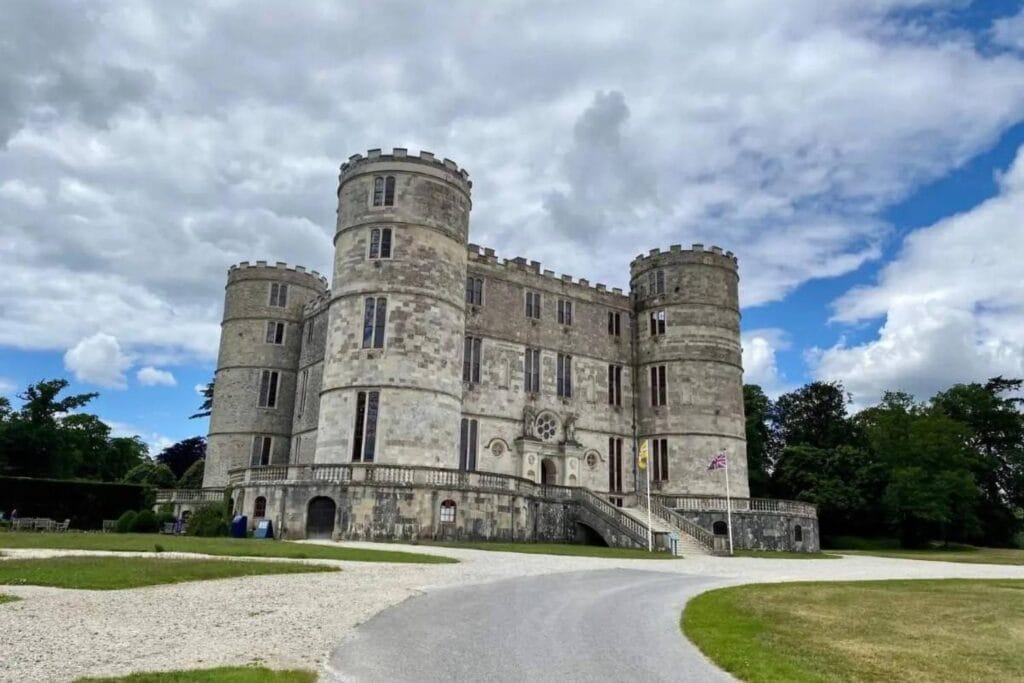Durdle Door, A Fabulous Day Out In Dorset!
Have you ever visited a place that felt like it was from another world, almost as if time had been frozen in an era of its own? If not, add Dorset’s majestic and awe-inspiring Durdle Door to your bucket list! This idyllic slice of England boasts stunning scenery and is a must-visit for anyone looking to explore the great outdoors.
This post may contain affiliate links. That means that if you click on a link and purchase something I recommend, I will receive a small commission at no extra cost to you. As an Amazon Associate, I earn from qualifying purchases. This helps keep my website up and running and is very appreciated. Thank you for your support! You can read my full disclosure policy here.
What Is Durdle Door?
Durdle Door in Dorset is a stunning natural attraction, and it’s not hard to see why so many people flock to the area each year! Sitting atop the Jurassic Coast, this fantastic landmark looks like a giant archway cut into the cliff face. The rock formed when an underground river eroded the softer part of the limestone bedrock over thousands of years, leaving tall cliffs and this magnificent opening that we can appreciate today. It’s also one of England’s most photographed places, as stunning views from near and far make for some beautiful shots.
Where Is Durdle Door?
Durdle Door is located in Lulworth, along England’s Jurassic Coastline, a UNESCO World Heritage site that stretches 96 miles through Dorset and Devon. The area is a geologist’s dream, telling the story of 250 million years of evolution. People worldwide descend on many of the area’s beaches, searching for fossils along its constantly eroding coastline.
Getting To Durdle Door:
By Car:
Durdle Door is located in the village of West Lulworth on the B3070, which leaves the A352 (Wareham to Dorchester road) at Holmebridge.
Sat nav:
Set SATNAV postcode to BH20 5PU for Durdle Door, West Lulworth, Wareham, Dorset.
Parking:
There are two parking locations at Durdle Door: standard and a pre-booked premium. Standard parking opens from 9 am to 9 pm and costs £10 for the whole day. However, you must get there early, especially in the peak summer season, as this parking fills up fast!
You can also pre-book parking in an adjacent car park for £10 for 4 hours and £15 for all day. The car park opens at 9 am and closes at 10 pm. You can pre-book parking on the Justpark website here.
By Train:
The nearest railway station is Wool (on the London Waterloo to Weymouth line by South Western Rail). Bus numbers 15, 30 and X55 connect Wool Railway Station to West Lulworth for Lulworth Cove and Durdle Door.
By Bus:
There are three bus services to West Lulworth for Lulworth Cove and Durdle Door (numbers 15, 30 and X55). Please check individual bus operators for times, as they are subject to seasonal changes.
Getting To Durdle Door From The Carpark:
Durdle door and the adjacent Man ‘O’ War beaches are part of the Lulworth Estate. Both these beaches are only accessible on foot via a steep path from the car park located on the cliff top next to the Durdle Door Holiday Park.
When I visited last summer, a one-way system was in place, taking visitors one way down to the beach and another back up to the car park. This made the walk down to the beach about 10 minutes longer; however, it gave the best views as you arrived at Durdle Door Beach.
The route first takes you up the hill next to the caravan park, then down through a small wooded area, across another field, and up another slight hill. I did wonder where the route was taking me at first, but it did open out to some of the most amazing views of Weymouth Bay. Defo worth the effort, if you ask me!


From this point, you only have to walk along the cliff top, and you will find the steps at the end of the trail that lead you down to either Durdle Door or Man ‘O’War Beach. Both beaches are equally nice; however, Man ‘O’ War is probably quieter. I spent most of my time taking photos, just wandering around and having a little paddle in the water. Although the sun was out, it wasn’t particularly hot, so I didn’t feel the need to take a proper dip. However, I did see some brave souls swimming!


Tips For Visiting Durdle Door:
Both beaches don’t have any facilities or lifeguards on duty, but there are public toilets and a couple of snack shops next to the car park. My advice would be to pack a picnic, pick out a nice spot and enjoy the beach, but keep an eye on young ones; currents can be stronger than you think.
Although both beaches are beautiful to admire from afar, they are challenging to walk on because they are pebbles, not sand. Sandals aren’t the most practical, as most of the tiny pebbles will easily find their way under your feet. Barefoot is a bit easier, but watch out for some sharper pebbles. I would recommend wearing full shoes whilst walking along the beach.
Other Places To Visit Nearby
Lulworth Cove
You can either spend most of the day relaxing and enjoying the beach at Durdle Door or, like me, walk along the coastal path towards the beautiful little village of Lulworth and its pretty cove.
The walk itself takes about 45 minutes and is not too strenuous to get there. However, the walk back will mean a huge hike up a very steep hill! If you don’t fancy walking, you can always take the short drive and park in Lulworth village. I believe the car park here only costs £5 for the day.
The coastal path can be reached by taking the steep gravel path back from Durdle Door towards the car park. The coastal path then continues from the car park and is well-signposted. The lovely walk offers fantastic views along the coast and then leads down a steep pathway towards the village.




Once in the village, you will find numerous shops, restaurants, and cafes as well as a visitor centre, which was unfortunately closed when I visited. The village itself is extremely pretty, with many thatched cottages and the typical Dorset stone houses.
You can either walk through the village towards the beach or take the scenic route and back up another hill to get fabulous views of the whole cove.




Once finished in Lulworth, I walked back to my car in Durdle Door. However, be prepared for the walk back up the hill. It’s gruelling! Although every time you stop to catch your breath, you are treated with some lovely views to make up for it!
Lulworth Castle:
Lulworth Castle is just a 10-minute drive from Durdle Door and stands in extensive parkland within the 20-square-mile Lulworth estate. Built in the 17th Century, this magnificent building is steeped in history. Originally built as a hunting lodge to entertain aristocracy and royalty, it was for centuries the family seat of the Weld family, the current owners of the Lulworth Estate.

Although the outside of the castle has remained the same since it was built, the inside has changed dramatically. In 1929, a fire raged through the castle, gutting the interior and leaving it close to ruin. However, the castle has been partially restored after a partnership with English Heritage.
Those with English Heritage membership can visit for free; otherwise, tickets cost £9 for adults and £6 for children.
The castle is open to the public Mon-Fri between 10.30 am and 5 pm. Parking on-site costs £3 (even for English Heritage members)
As you step inside the castle, you will see that most of it is still in ruins. However, you can still glimpse what it must have been like in its heyday. One of the towers has been fully restored so that you can climb up it, but it was closed the day I visited due to social distancing measures.
You can still walk through the one-way system into the different areas and rooms within the castle. Some have been dressed as they would have been hundreds of years ago. There are also many information stations and a small museum that gives more information about life for those living and working within the grounds.




After wandering around the castle, I grabbed a coffee and walked around the grounds. Just next to the castle, you will find a lovely little church, which again was closed, and the unusually designed Chapel of St Mary.
The chapel is considered the first free-standing Roman Catholic Church built for public worship in England since the Reformation. This was due to some crafty architectural design. King George III gave the family permission in 1786 to build a mausoleum, stating, ‘You may furnish it inside any way you wish.’ It wasn’t until five years later that Catholics could legally worship again in public.
Final Thoughts
Durdle Door, Lulworth Cove and Lulworth Castle are all great places to visit if you’re ever in the area. They each offer something unique and beautiful that is definitely worth seeing. I highly recommend stopping at all three of these fantastic places!
Thanks so much for stopping by; I appreciate everyone who takes the time to read and make it to the end! I have lots of exciting new content in the next few weeks, so make sure you pop back to catch up!
Remember to follow my social media accounts for more travel inspiration and updates.
Happy travels!



